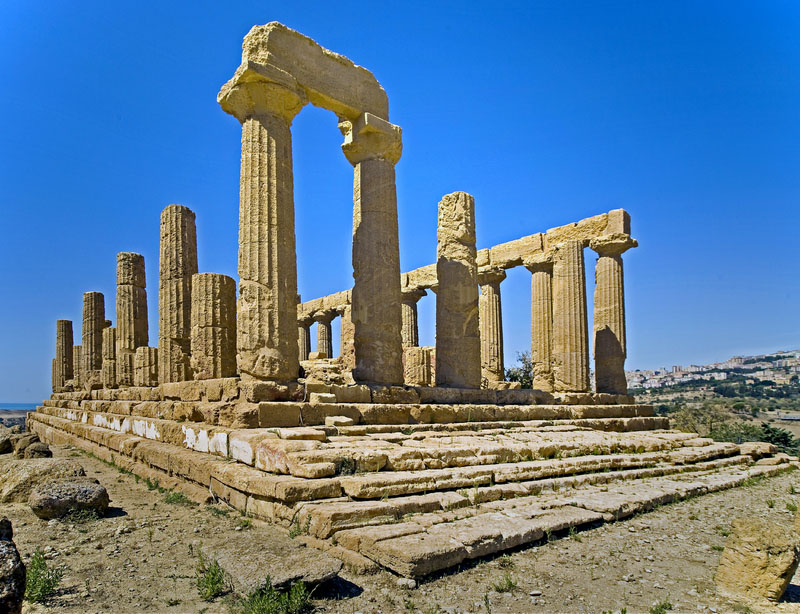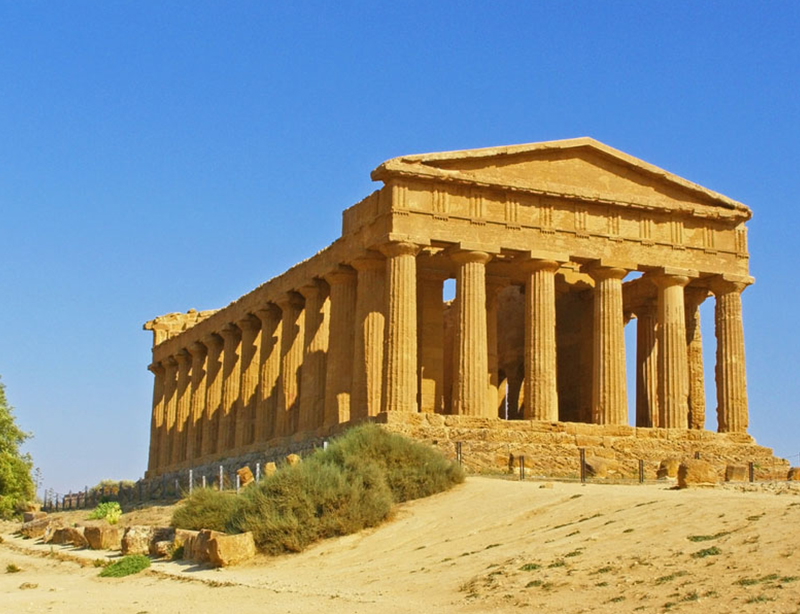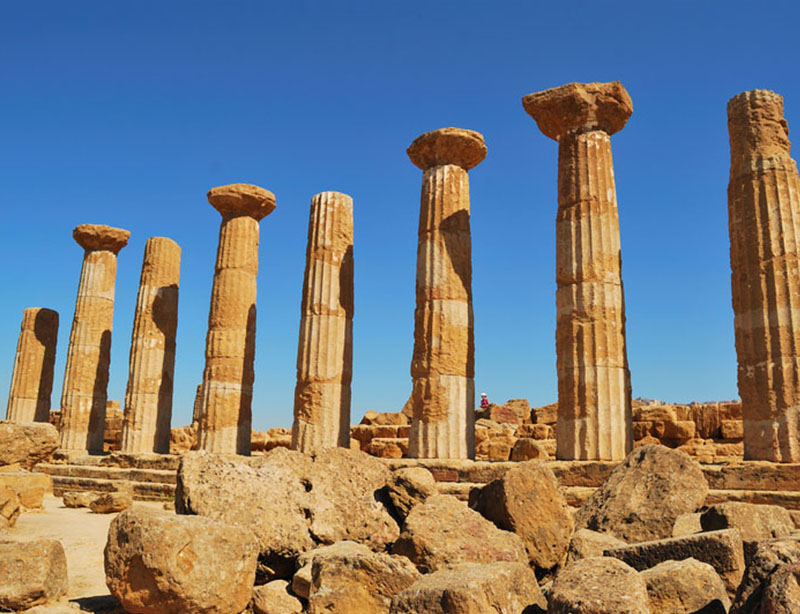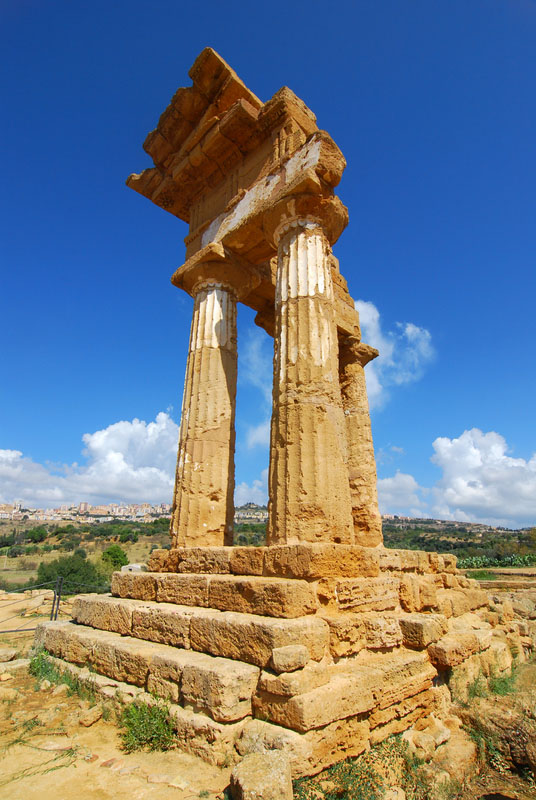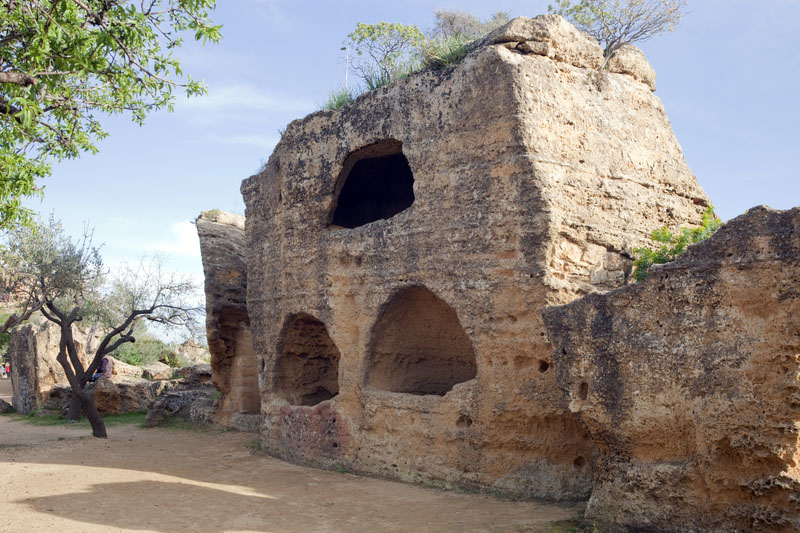The Valley of Temples in Agrigento is one of the most beautiful archaeological parks and best preserved in the world.
The seven Doric temples form one of the most beautiful monumental complexes of Greek art in existence.
The visit to the Valley takes place immersed in a stunning landscape context, characterized by the harmony of the whole among the surrounding nature and the remains of the ancient Greek colony.
The amber color of the temples, really impressive at sunset, the green fields and the unique spectacle of the almond trees in bloom in the spring, offering visitors unforgettable sceneries.
The visit of the archaeological park begins with the ancient Temple of Demetra built in 480 a.C., and now incorporated by the ancient church of San Biagio, built in the Norman period on the remains of the temple; the rupestrian sanctuary of Demetra, the most ancient holy place of Akagras, characterized by the three tunnels dug into the rock and from the antique rectangular vestibule; the Temple of Juno Lacinia (or Temple of Hera Lacinia), Doric temple built in the fifth century a.C. situated on a hill, which preserves the colonnade, the architrave and some isolated columns; the Temple of Concordia, built in 430 a.C., one of the best preserved Doric temples in the world, which houses the six columns of its facade and the thirteen lateral columns, the podium, the pediments and the frieze; the Villa Igea, surrounded by a beautiful garden, preserves the remains of some Christian tombs and a necropolis, known as the Cave of Frangipane or Ipogei of Villa Igea; the Temple of Hercules (or temple of Heracles), the oldest Doric temple among the temples of Agrigento, erected in the sixth century a.C., of which rest only eight columns, some with capitals still intact, and the remains of the altar; the Tomb of Theron, sepulchral monument, from the Roman era, is a typical testimony of the funerary architecture; the sanctuary of Demeter and Kore (or Persephone), an ancient place of worship where you can visit the remains of temples, altars and sacred enclosures; the Temple of Castor and Pollux, also known as the Temple of Dioscuri, built in the fifth century a.C., the symbol of the Valley of the Temples and of the city of Agrigento, of which remain four columns; the Temple of Olympian Zeus, one of the greatest of the ancient Greek temples built in memory of the victory against the enemies Carthaginians in the famous battle of Himera in 480 a.C., where you can visit the ancient ruins, among which the mastodontic Telamon, figure depicting a giant nine feet tall with his arms raised to the sides of the head to support the weight of the cornice and support the roof of the temple.
One of the Telamons is preserved in the Archaeological Museum with other remains of Telamones founded during archaeological excavations.
The Temple of Vulcan, from the fifth century a.C., one of the most impressive temples of the Valley of Temples; the Church of St. Nicholas, situated on a hill that overlooks the Valley of Temples, built in Gothic style in the year '200, preserve the unfinished facade consisting from a portal in the form of pointed arches, and, on the inside with a single nave, four chapels, one of which houses a celebrated sarcophagus, dating back to Roman times, decorated with beautiful bas-reliefs.
Near the church you can visit a small temple, called Oratory of Phalaris, from Roman times, and an auditorium carved into the rock.
Near the church there is the Regional Archaeological Museum, consists of thirteen rooms in which is represented the history of Agrigento and of the surrounding area, with exhibits ranging from the prehistoric era, to the Christian and archaic and classical greek period.
The Museum is housed in the convent of St. Nicholas of the '300.
Among the various works preserved we mention the gigantic Telamon, the remains of other Telamones recovered during the countless archaeological excavations, a fragment in marble of a Warrior dating from the fifth century a.C., a collection of vases dating from greek period, a lovely ancient mosaic depicting a Gazelle to the source dating from around the second century d.C., the archaic Ephebus, of the fifth century a.C. and a statue of Venus (or Aphrodite) to the bath.
The Hellenistic-Roman Quarter rises near the church of San Nicola and extends for more than eleven thousand square meters.
It consists of four main streets that run through the neighborhood in parallel and intersecting each other.
Laterally to the streets there are houses in Hellenistic and Italic style, decorated internally with polychrome plasters on the walls and with mosaics of different styles in flooring, dating back to the Roman period and the imperial period as the mosaics of the House of Gazzella.
The Hypogeum Giacatello, large subterranean environment in which flowed the water and having the function of water supply of the city.
Covering the road that connects the old town to the modern you can see the Rupe Atenea, considered to be the site where once arose the acropolis, from wich you can admire a magnificent panorama.
